How to Make a Tree Healthy Again
How to Save a Dying Tree: Easy Tree Health Success

It's a rare outcome that a tree gets sick. If you lot're wondering how to save a dying tree, y'all're ane of the unlucky, only information technology's not a random curl of the dice.
Most trees, in one case established and mature, take the power to fend off disease, problems associated with insects, and farthermost conditions conditions.
Simply once a tree's health is compromised, it becomes vulnerable to all of the to a higher place problems, making it crucial to human activity equally before long as possible. I'll help you identify the problem and provide some actionable steps you can do to restore your tree to total health.
Learning how to revive a dying tree is the hard part, simply nosotros've made it easy here. The easy part is the healing process.
How to Relieve a Dying Tree
First and foremost you lot need to ostend that your tree is, infact, dying. Below this section I list out the signs of a dying tree that will help you lot confirm the problem. Second, you need to identify the specific problem.
Sometimes taking the general steps in this department is plenty to help the tree get enough strength to ward off the disease itself. Other times you lot'll demand to apply some specific deportment, which we signal out below.
These tin can include pesticides, restoring macronutrients to the soil, and more than. In the worst instance scenario y'all can consult a professional arborist.
Correct Moisture Problems
Mature trees tend to be able to survive dry seasons or even overly wet ones. Younger trees can face issues associated with too much or also trivial water.
Over-watering is often a weather issue and not one you lot're creating by watering the lawn. It has to practice with the drainage of the soil effectually the tree.
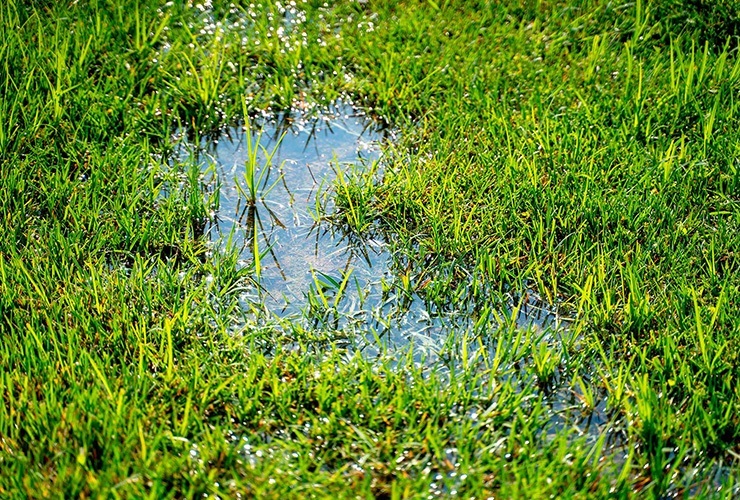
Look for water-logging, where the roots of the tree have get soft and soggy. Other signs include the growth of various types of moss and molds on the dirt around the tree and a lack of grass.
If the soil around the tree is constantly saturated with water, this is a problem and y'all need to work on getting water to bleed away from that area or introduce more sunlight.
If you believe nether-watering is the outcome, this is easy to solve with a garden hose or an automatic or culling sprinkler system. You can even fill up a v-gallon saucepan with h2o and behave it to the tree. Whatever it takes for our friend to feel better!
Don't Add to Much Mulch
Mulch is bully, just there's a common problem where people tend to build up a cone around the base of the tree using mulch. I'thou not sure why, but so many people exercise this. At that place are a ton of problems associated with this:
- The roots can't breathe
- The roots and trunk can begin to rot
- Insects, fungi, and bacteria will infest and infect the area
If you lot're placing thick layers of mulch around the tree, simply sparse that area out. If you lot've allowed mulch to build up effectually the base of the trunk, y'all need to remove all of it.
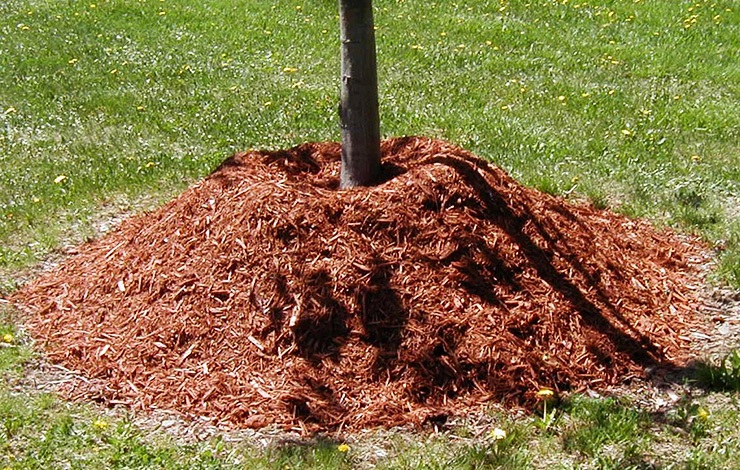
The aforementioned goes for fertilizer. Don't build up a mound around your tree! Fertilizer especially tin can have sick furnishings, such equally "burns" due to the chemical makeup.
Apply the Correct Fertilizer
Many people simply buy an all-purpose fertilizer and chuck around the tree like mulch. That can exist fine but it can also be deadly. What you lot actually need to practise is perform a soil test in the surface area of the dying tree and detect out exactly what macronutrients are missing.
These are nitrogen, phosphorous, and potassium, which are what the fertilizer numbers represent on the front of the bags.
Only like mulch, too much fertilizer can allow all kinds of bad bugs and bacteria to make a home around the roots of your tree, which you can think of as the tree'due south rima oris. We don't let bugs make a nest around our mouths any more than than we should allow that for a tree.
Direct contact of the fertilizer on the roots can also "burn" them chemically, and then go light if you're sprinkling information technology that close to the tree.
Clip the Sick Limbs
This is tricky because information technology's hard to know how far a disease has spread, but information technology is possible to remove visibly diseased areas from an otherwise healthy tree. Past pruning limbs or fifty-fifty sections of bark and trunk, yous tin can terminate the illness from spreading.
Make sure, afterward doing this, that y'all sterilize your shears, saws, and knives you used to perform the job.
Make sure you research how to prune the type of tree yous're working with. There are various pruning techniques that are advisable for specific species of trees. Astringent pruning can send the tree's system into shock, and it's already struggling, so delight take care when doing this.
Signs of a Dying Tree
Before you kickoff going to piece of work to save a tree, you need to make certain information technology actually needs saving and you're not being overly cautious. There are some obvious signs a sick tree will give.
Dried Leaves
If a tree's foliage becomes crunchy or loses its leaves during the spring or summer seasons, that'south a sign there is a problem. But don't overreact during the fall or winter months.
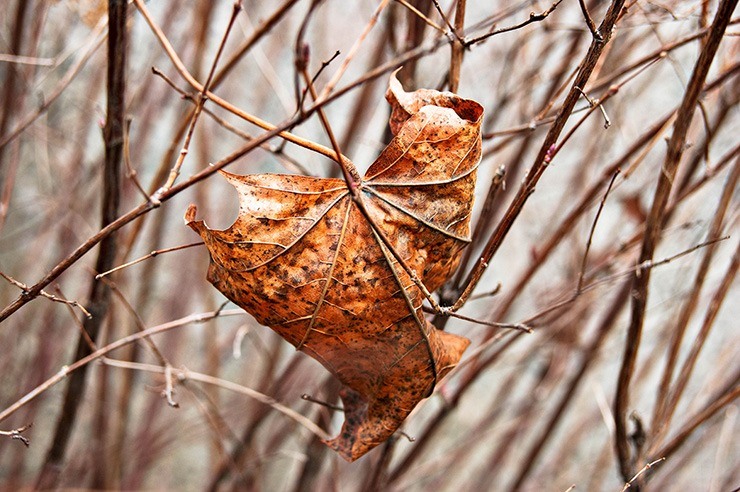
You may notice some branches are completely salubrious and total of leaves while others are scanty, or that the entire tree has less leaves than others of the same species at the same time. That's a bad sign.
Weak Branches
Sometimes the leaves may be doing fine simply you lot discover the branches are starting to sag under their own weight. This happens especially with trees with many and heavier leaves, like the types of willow trees, for instance.
If you see the branches losing strength and sinking under the weight of their own sub-branches and leaves (and even worse during and after a pelting), then your tree is probable sick to some degree.
Focus your attention where the branches dissever off into child branches. Practice these joints seem like they could break eventually? Poor joints are a bad sign.
Dried Branches & Body
Branches should bend some, fifty-fifty in more naturally brittle copse. Check to see if the branches are even so pliable. If they begin to crack and snap far also soon, then y'all're looking at deadwood.
All copse have elasticity, even in the trunks, or they wouldn't exist able to survive well-nigh winds. A lack of elasticity is a very bad sign.
Softness & Disuse
If you lot find softness and decay that's not related to water-logging, this is a very bad sign that your tree is dying, because it'due south not fighting off affliction, bacteria, and fungus.
Some fungus or mushrooms growing on the trunk and roots can be fine. But you'll know at that place's a problem when entire areas accept become extremely soft to your affect.
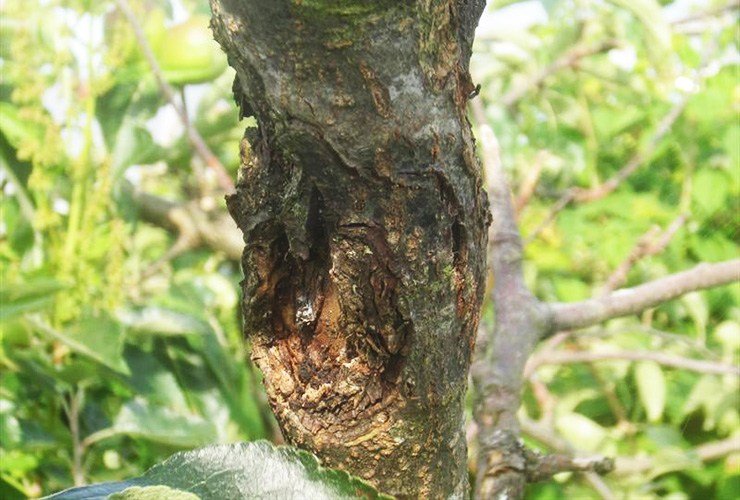
Look for what are called "cankers," which are sores acquired by bacteria and fungi that infect the tree, creating an open wound.
You lot need to clip these areas soon, because then the illness tin penetrate deep into the tree and get beyond the exterior defenses. This stress will make the tree far more vulnerable to other issues.
Leaning Tree
When a tree is dying, the root system becomes weak and the tree can outset leaning. I'm not talking about a younger tree growing towards the sun, but the unabridged construction leaning to one side from the roots and up.
This is because the roots aren't able to hold it in place in the soil, a big sign at that place's an illness involved.
Saving a tree that is leaning isn't worth attempting. Y'all should consider having it removed, peculiarly if information technology is leaning towards your house, garage, carport, or those of a neighbour. Information technology'due south unfortunate but safe matters more.
Tin can a Dead Tree Exist Revived?
Can a half dead tree be saved? Yes, that's basically what we've been talking about. Merely can a dead tree be revived, as in a fully expressionless tree?
Sometimes you can do your all-time and experience new leaf and branch growth starting lower nearly the base of operations, spawning off of new roots or a revived root organization. But in general, no, you won't revive the entirety of the tree.
Causes of a Tree Dying
We mentioned higher up about over and nether-watering, a lack of soil nutrients, mulching and fertilizer problems, and disease. Established trees are resistant to most everything, including these problems, except for the worst diseases.
Here are a few mutual diseases you may encounter:
American Chestnut Bane - Caused by the pathogen cryphonectria parasitica, information technology can cause sunken cankers, orange-colored spots forth branches or the torso, and even cause xanthous spores to exist emitted.
Professionals tin can apply a soil shrink cure or a hypovirulence transfer.
Powdery Mildew - Caused by fungi in the society Erysiphales, it starts on the leaves of the lower branches and works its fashion upwardly the tree from in that location.
It grows a white, powdery layer over fruits and leaves, which eventually turn gray and then blackness. Fungicides like triademefon and propiconazole volition finish this disease.
Sudden Oak Decease - Caused by a pathogen named phytophthora ramorum, the virtually outward symptom is that the bark of the trunk will divide and begin weeping a dark brownish sap.
Eventually the leaves and newer shoots lose their color and wilt. The v-week treatment consists of spraying a phosphonate-based surfactant on the body.
Dutch Elm Disease - Caused by the ascomycete microfungi spread by the American bark beetle, this disease spreads to other trees quickly through the root system hole-and-corner.
Symptoms include wilting and yellowing of branches and leaves starting at the crown and moving downwards to the base of the trunk. The course of action is to prune the infected limbs and utilise a fungicidal injection.
Fire Blight - Caused by erwinia amylovora, this disease affects fruit trees mainly, making them take the appearance of a burnt tree. Affected trees will compress in size and become blackened.
Professionals propose pruning afflicted areas every bit early as noticed and spraying the tree with antibiotics like terramycin and streptomycin.
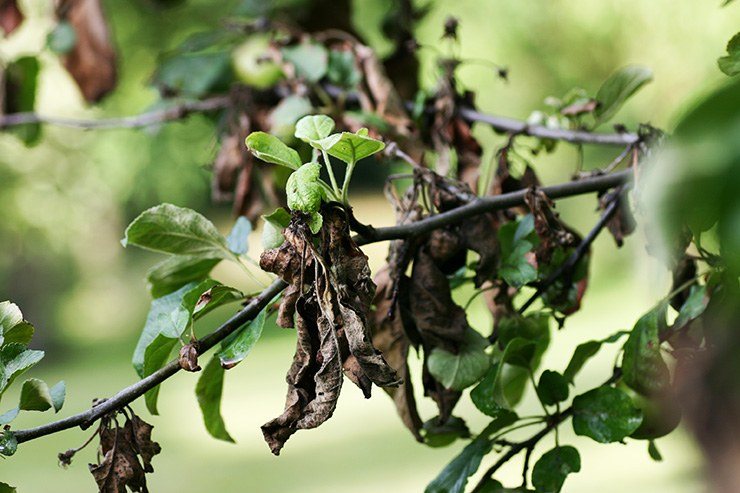
Those fruit trees not planted during the best fourth dimension to plant fruit trees will be a fleck more vulnerable until they're established, though whatsoever can succumb to this illness.
Tips to Keep Your Tree From Dying
Hither are some additional tips to boost the health of your tree in addition to those mentioned to a higher place. During the dry out winter months, trees require little to no nitrogen but still need phosphorous and potassium.
Consider creating a liquid solution of 0-20-20 fertilizer and watering information technology directly to the tree's roots.
Try to avoid running over exposed tree roots with your lawn mower. Cutting the tops of the roots down creates injuries that invite leaner and fungi into the tree'due south system. In the same vein, avert using weed killers nigh your trees.
One time you lot prune an ill tree, make certain to sterilize the equipment before working on another tree of found or you risk introducing the affliction to more trees. Watch out for water-logging in areas with poor drainage, and the aforementioned goes for over-watering on your role.
As well much mulch around your trees ways there won't be enough drainage and the roots won't take admission to air hands.
Is My Tree Dying or Dormant?
Plainly a fallow tree is not dead, but in a land of low growth and preservation, like to hibernation. It's easy to confuse the two due to the most outward symptoms of both being similar, in which leaves wilt, dry out upwardly, and fall away.
If you're trying to determine how your tree is doing, and it's belatedly autumn or during the wintertime, you either need to wait until the spring to brand a determination or rent an arborist to visit and run some tests. At that place are a few small tests you lot can run yourself.
Run into if the branches will nevertheless curve without snapping or swell. If it does break, check the inside of it to run into if it is totally dry or if there are signs of life within. You can scratch away the bawl of the co-operative and see if there is any greenish growth beneath.
Consult an Arborist
In a worst case scenario you can contact an arborist, which is basically a tree doctor. They tin can run tests on specific trees, identify at-adventure copse, spray with preventative chemicals, and brace your copse for added back up.
They tin can also help with pruning, alert you most symptoms of diseases spreading in the area, inform y'all about the laws in your county for deforestation and using chemicals, and can even let yous know if you have whatever valuable trees you could sell for lumber.
They're also qualified to climb up your trees, use heavy equipment when removing dead trees, and more. They can tell you exactly what types of dogwood trees you have, for instance.
If you lot're unsure about anything but value your copse likewise much to stand losing them, then definitely consult a local arborist.
How to Bring a Dying Tree Back to Life
When trying to salve a dying tree that's having problems from anything but a serious disease, the tips higher up will be more than than enough. For those with big, problematic diseases, you'll need to contact an arborist to get a real medical treatment in place.
And remember, yous tin can revive a ill tree, but not a dead one. Accepting that sooner than afterwards can relieve you from it falling over and costing you a lot of coin.
Y'all'll Also Savour:
- Fertilizer Numbers: What N-P-K Numbers Mean
- 0-xx-xx Fertilizer: Why Nil Nitrogen Mixes Reign Supreme
- Best Time to Plant Fruit Copse By Season & Type
- 21 Plants That Repel Ticks: Fresh Smells We Love & Ticks Hate!
- Maggots in Compost: Good or Bad? Hither'south What to Do
How to Make a Tree Healthy Again
Source: https://worstroom.com/how-to-save-a-dying-tree/
